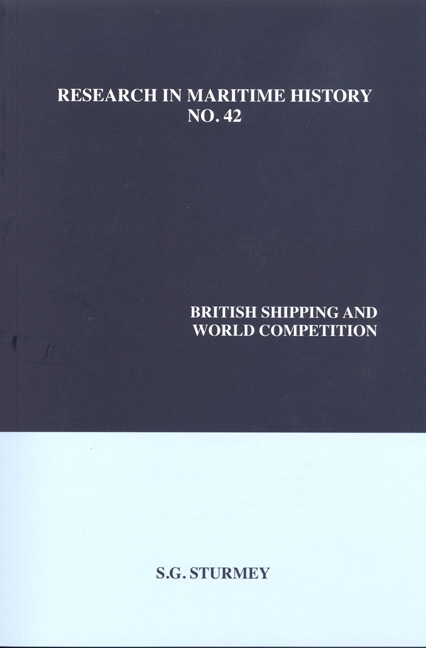Book contents
- Frontmatter
- Table of Contents
- Series Editor's Foreword
- About the Author
- Preface
- Figures and Tables
- Chapter 1 The Problem Defined
- Chapter 2 High Water: The Pre-1914 Period
- Chapter 3 War and Reconstruction
- Chapter 4 The Troubled Years: The Interwar Period
- Chapter 5 Nationalism in Shipping in the Interwar Years
- Chapter 6 The Birth of the Liberty
- Chapter 7 The Prosperous Age: The Postwar Period
- Chapter 8 Enemies of Competition in the Postwar Years
- Chapter 9 Flags of Convenience
- Chapter 10 Economics of Shipping Enterprises
- Chapter 11 Shipowning and Resource Allocation
- Chapter 12 Labour Relations and Labour Costs (by Basil Mogridge)
- Chapter 13 The Conference System
- Chapter 14 The Structure of the British Industry
- Chapter 15 The Question Answered
- Epilogue The Future
- Appendix The Contribution of British Shipping to the Balance of Payments
- Bibliography
- Index
Chapter 3 - War and Reconstruction
- Frontmatter
- Table of Contents
- Series Editor's Foreword
- About the Author
- Preface
- Figures and Tables
- Chapter 1 The Problem Defined
- Chapter 2 High Water: The Pre-1914 Period
- Chapter 3 War and Reconstruction
- Chapter 4 The Troubled Years: The Interwar Period
- Chapter 5 Nationalism in Shipping in the Interwar Years
- Chapter 6 The Birth of the Liberty
- Chapter 7 The Prosperous Age: The Postwar Period
- Chapter 8 Enemies of Competition in the Postwar Years
- Chapter 9 Flags of Convenience
- Chapter 10 Economics of Shipping Enterprises
- Chapter 11 Shipowning and Resource Allocation
- Chapter 12 Labour Relations and Labour Costs (by Basil Mogridge)
- Chapter 13 The Conference System
- Chapter 14 The Structure of the British Industry
- Chapter 15 The Question Answered
- Epilogue The Future
- Appendix The Contribution of British Shipping to the Balance of Payments
- Bibliography
- Index
Summary
The 1914-1918 war had a lasting effect on the position of British shipping. The consequences of the war to shipping “were more direct, more extensive, more lasting and possibly more significant than on any other branch of economic activity.” It is no part of the present work to present a summary history of British shipping in the war; “on that subject one must write either a volume or nothing at all.” All that is intended is to note those aspects of the war which apparently had a significant effect on the future of the industry.
Britain entered the war with 19.26 million tons of sail and steam ships of over 100 tons, 39.4 percent of the world total; by June 1919 the fleet had been reduced to 16.56 million tons, 32.5 percent of world tonnage. The difference between the 1914 and 1919 figures represents war losses not made good. During the war, world shipping losses amounted to fifteen million tons, about two million tons of which were lost by ordinary marine risks (from 1910-1913 marine losses had averaged 605,000 tons per annum). British losses were nine million tons and foreign losses six million tons. The total world fleet increased in the period by about four million tons, so that while the British fleet decreased by three million tons, the foreign fleet increased by seven million tons.
The experiences, in terms of tonnage losses, of a number of leading maritime countries are shown in table 3.1. Tonnage figures are shown for 1914, 1919 and 1920, the 1920 figures being included to show the effects of the post-war distribution of enemy fleets among the Allied nations. The shipping of America, Japan, France and Italy seems to have profited most from the war. These four countries will be considered first, followed by the neutral countries, then the enemy countries and finally Great Britain.
(a) American Shipping
The fleet which secured the most spectacular wartime growth was that registered under the American flag. By 1914, the American sea-going fleet had decreased to the point where it carried only ten percent of the American seaborne international trade. This was a situation which some Americans viewed with disquiet, but the economic justification was sufficiently strong for the pressure for a greater American share of the trade to be largely ignored.
- Type
- Chapter
- Information
- British Shipping and World Competition , pp. 31 - 52Publisher: Liverpool University PressPrint publication year: 2009



